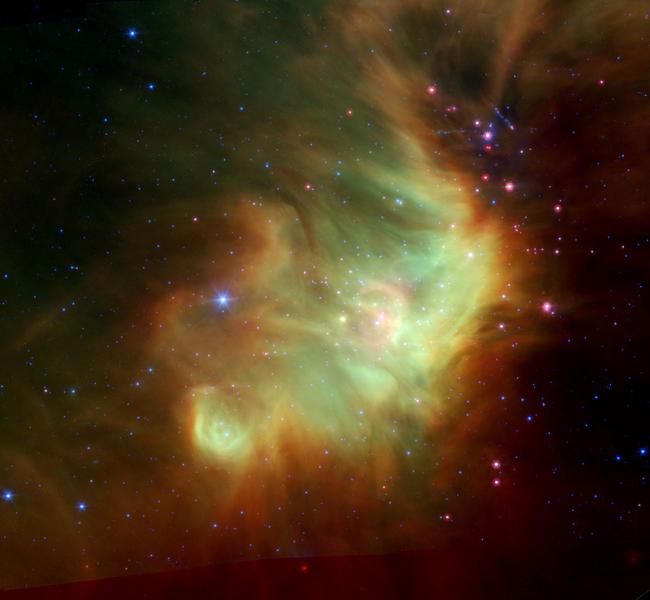
Baby stars are forming near the rim of this cosmic cloud in the constellation of Perseus, as seen in this infrared image from NASA's Spitzer Space Telescope. SAO astronomers completed a census of the cloud, and find a new population of very young stars, shown as reddish-pink dots to the top-right of the image.
The glowing nebula of warm gas and dust known as IC348 is located about 1,000 light-years from Earth, in the direction of the constellation of Perseus. It has long been known that IC 348 is an active stellar nursery, but no one had ever been able to make an accurate census of its population because most of its young stars are deeply embedded in their natal, obscuring dust cloud. In fact, it was not until late in the last century that infrared instruments discovered that there even were extremely young stars in the nebula, and that the processes of stellar birth there were still active. Today we know that the nebula has a population containing at least 300 young stars whose median age is only about 2-3 million years. Most of them are clustered together near the center of the nebula, but astronomers trying to unravel the secrets of star formation -- where and how are they born, and what kinds of stars do they form? -- wanted to obtain a complete census to be certain they were not overlooking either important members or significant processes. The Sun presumably also formed in a cluster similar to this one.
SAO astronomers August Muench and Charlie Lada, together with three of their colleagues, have used the Spitzer Space Telescope's infrared cameras to study the entire IC348 cloud, including its edges, and to identify and classify as many of its total population as could be found. They uncovered about sixty previously unknown young, new stars.
They report that about thirty-one stars of the whole ensemble are very young and still growing through accretion of material from a surrounding cloud. Another 118 stars have stopped growing and show evidence for a surrounding disk of material, usually suspected as a signpost of future planets. Furthermore, they have discovered that the youngest stars are not located near the older ones, but in a filamentary ridge of material near the edges of the cloud, a result that confirms the value of searching an entire region (not just the obvious places) before drawing general conclusions. Not least, the scientists calculate that the nebula has been producing new stars at a more-or-less steady rate of one new star every twenty thousand years, and must have been doing so for the past 2.5 - 5 million years. The results show that although star formation can proceed quickly after a stimulated burst of activity, in typical nebulae it continues at a steady pace for a long time. While the primordial structure of the IC348 nebula has dissipated over time, it is clear that stars here tend to form in filamentary structures. Perhaps the Sun also began in a similar, filamentary nursery that has long since evaporated.